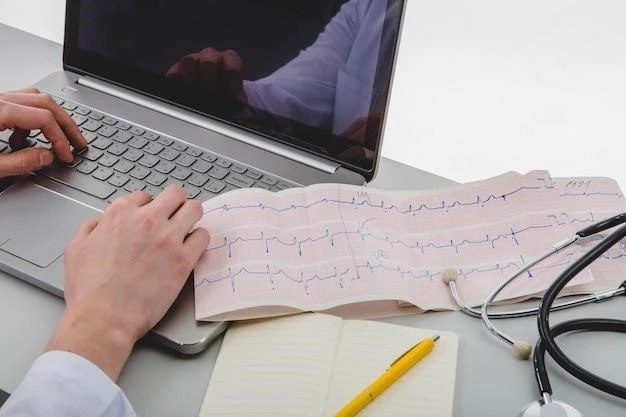Understanding Bidirectional Tachycardia is crucial for proper management and treatment of this condition.
Definition and Overview
Bidirectional Tachycardia is a rare cardiac arrhythmia characterized by the heart beating unusually fast and in two different directions. It presents a unique challenge in diagnosis and management due to its complex nature and potential impact on cardiovascular health.

Causes of Bidirectional Tachycardia
Bidirectional Tachycardia can be caused by genetic factors or acquired conditions affecting the heart’s electrical system.
Genetic Factors
In some cases‚ Bidirectional Tachycardia can be linked to inherited genetic mutations affecting ion channels in the heart‚ disrupting the normal cardiac rhythm. These genetic abnormalities can predispose individuals to develop this unique form of arrhythmia.
Acquired Conditions
Bidirectional Tachycardia can also result from acquired heart conditions such as electrolyte imbalances‚ myocardial ischemia‚ certain medications‚ or structural heart abnormalities. These factors can disrupt the heart’s electrical system‚ leading to the development of this specific type of arrhythmia.
Symptoms and Diagnosis of Bidirectional Tachycardia
Bidirectional Tachycardia may present with specific symptoms and can be diagnosed through various medical tests.
Common Symptoms
Common symptoms of Bidirectional Tachycardia may include palpitations‚ dizziness‚ chest pain‚ shortness of breath‚ and in severe cases‚ loss of consciousness. It is essential to recognize these signs and seek prompt medical evaluation for accurate diagnosis and appropriate management.
Diagnostic Procedures
Diagnosing Bidirectional Tachycardia may involve various diagnostic procedures such as electrocardiograms (ECG)‚ Holter monitoring‚ electrophysiology studies‚ and cardiac imaging tests like echocardiography. These tests help healthcare providers assess the heart’s electrical activity‚ identify arrhythmias‚ and determine the underlying cause of the tachycardia.
Treatment Options for Bidirectional Tachycardia
Managing Bidirectional Tachycardia involves various treatment modalities to control the heart rhythm.
Medication
Medications like antiarrhythmics or beta-blockers may be prescribed to help manage and control the heart rate in patients with Bidirectional Tachycardia. These medications aim to stabilize the heart’s rhythm and reduce the risk of recurrent arrhythmias.
Cardioversion
Cardioversion‚ a procedure that restores the heart’s normal rhythm through electrical shock or medications‚ may be recommended for patients with Bidirectional Tachycardia who have persistent arrhythmias. This intervention aims to reset the heart’s electrical activity and improve cardiac function.
Ablation Therapy
Ablation therapy‚ a minimally invasive procedure‚ may be utilized to treat Bidirectional Tachycardia by targeting and destroying abnormal heart tissue responsible for the arrhythmia. This approach aims to restore the heart’s electrical pathways to their normal function‚ improving the patient’s overall cardiac health and reducing the recurrence of tachycardia episodes.
Prognosis and Complications of Bidirectional Tachycardia
Understanding the prognosis and potential complications associated with Bidirectional Tachycardia is essential.
Outlook for Patients
The outlook for patients with Bidirectional Tachycardia varies depending on the underlying cause‚ response to treatment‚ and overall cardiac health. With appropriate management and follow-up care‚ many individuals can effectively control their condition and lead a quality life. However‚ complications may arise in some cases‚ underscoring the importance of ongoing monitoring and adherence to treatment strategies.
Potential Complications
Bidirectional Tachycardia can lead to potential complications such as heart failure‚ stroke‚ and in severe cases‚ sudden cardiac arrest if not managed effectively. It is crucial for individuals with this condition to be aware of these risks and work closely with healthcare providers to mitigate them through appropriate treatment and lifestyle adjustments.
Lifestyle Management for Bidirectional Tachycardia
Implementing lifestyle modifications can play a crucial role in managing Bidirectional Tachycardia effectively.
Diet and Exercise Recommendations
For individuals with Bidirectional Tachycardia‚ following a heart-healthy diet low in sodium‚ saturated fats‚ and added sugars can help manage the condition. Engaging in regular‚ moderate exercise under medical supervision is also beneficial for overall cardiovascular health. It’s essential to consult healthcare professionals for personalized recommendations based on individual needs and medical history.
Stress Management Techniques
Implementing stress management techniques such as deep breathing exercises‚ mindfulness practices‚ and stress-reducing activities like yoga or meditation can help individuals with Bidirectional Tachycardia better cope with emotional stressors that may exacerbate the condition. It is vital to prioritize mental and emotional well-being as part of holistic care for managing this cardiac arrhythmia effectively.
Research Advances in Bidirectional Tachycardia
Staying informed about the latest research developments is crucial for advancing the understanding of Bidirectional Tachycardia.
New Treatment Approaches
Ongoing research in Bidirectional Tachycardia is exploring novel treatment approaches such as advanced ablation techniques‚ innovative antiarrhythmic medications‚ and device-based therapies to improve outcomes and enhance quality of life for individuals affected by this complex arrhythmia. These advancements hold promise for more targeted and effective management strategies.
Ongoing Clinical Trials
Current clinical trials in Bidirectional Tachycardia focus on evaluating novel therapies‚ optimizing treatment outcomes‚ and understanding the genetic underpinnings of this arrhythmia. By participating in these trials‚ patients can contribute to the advancement of medical knowledge and potentially access cutting-edge treatments not yet widely available‚ offering hope for improved management of this complex cardiac condition.
Frequently Asked Questions about Bidirectional Tachycardia
Providing answers to common queries can help individuals better understand this complex cardiac condition.
What Are the Risk Factors for Developing Bidirectional Tachycardia?
Risk factors for developing Bidirectional Tachycardia include genetic predisposition‚ underlying heart conditions‚ electrolyte imbalances‚ certain medications‚ and structural abnormalities. Understanding these risk factors is crucial in identifying individuals at higher risk and implementing appropriate preventive measures and early interventions.
Can Bidirectional Tachycardia Be Prevented?
Preventing Bidirectional Tachycardia involves managing underlying heart conditions‚ avoiding triggers like excessive stimulants or electrolyte imbalances‚ following a heart-healthy lifestyle‚ and adhering to prescribed medications. While complete prevention may not always be possible‚ proactive measures can significantly reduce the risk of developing or worsening this complex arrhythmia.
